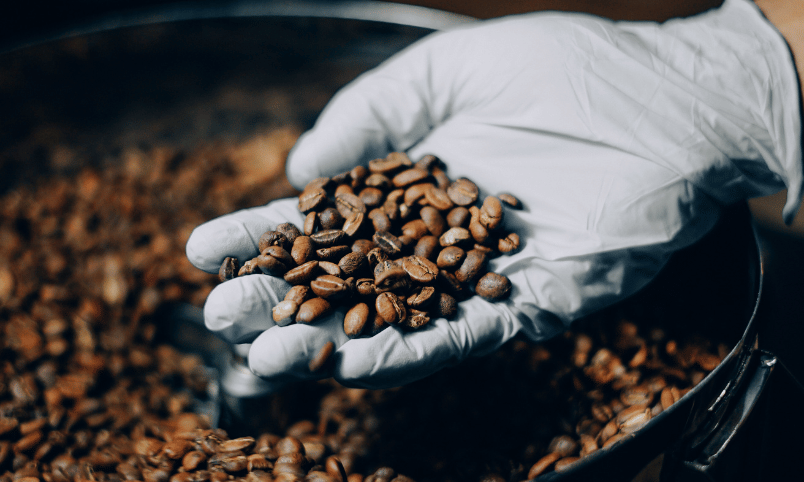By Esabda
Are you a coffee enthusiast with a passion for roasting and an entrepreneurial spirit? Starting a coffee roasting business can be an exciting venture that allows you to turn your love for coffee into a profitable enterprise. This article will guide you through the essential steps to start your coffee roasting business successfully. From sourcing high-quality beans to marketing your products, we’ll cover everything you need to know to get started.
Introduction: The Thriving Coffee Industry
The coffee industry is thriving, with an increasing number of consumers seeking high-quality, specialty coffee. This presents a golden opportunity for aspiring entrepreneurs to enter the coffee roasting business. However, starting a successful coffee roasting venture requires careful planning, attention to detail, and a deep understanding of the market.
According to the research done by Statista, the Coffee segment is experiencing impressive growth, with revenue expected to reach US$495.50 billion in 2023. The United States generates the highest revenue, while per-person revenues are estimated at US$64.50 in 2023. Out-of-home consumption is expected to contribute significantly to spending and volume consumption. By 2025, the market is projected to reach 7.78 billion kg in volume. These statistics highlight the thriving nature of the Coffee industry, presenting lucrative opportunities for businesses.
Also read the article on How Much Profitable Is A Coffee Roasting Business?
7 Steps to Start a Coffee Roasting Business
Here are the 7 easy steps that will guide you to start a profitable coffee roasting business:
Step 1: Research and Planning
Before diving into the world of coffee roasting, it’s crucial to conduct thorough research and develop a solid business plan. This step will lay the foundation for your future success.
Defining your target market
Identify your target audience. Are you targeting local consumers, online customers, or wholesale clients? Understanding your target market will help you tailor your products, pricing, and marketing strategies accordingly.
Conducting market analysis
Analyze the coffee industry in your area to identify potential competitors, market trends, and customer preferences. This information will guide your decision-making and help you identify gaps in the market.
Identifying your unique selling proposition
When starting a coffee roasting business, it’s essential to identify your unique selling proposition (USP). Your USP sets you apart from competitors and gives customers a reason to choose your roasted coffee.
It could be based on factors like high-quality beans, unique flavor profiles, sustainability, or personalized experiences. By highlighting your USP, you can differentiate your brand and attract coffee enthusiasts, establishing a strong position in the market.
Step 2: Setting Up Your Roasting Facility

Once you have a clear plan in place, it’s time to set up your coffee roasting facility. This step requires careful consideration of various factors to ensure optimal production and efficiency.
Choosing the right location
Select a location that provides sufficient space for your roasting equipment, storage, and potential future expansion. Consider proximity to transportation routes and accessibility for suppliers and customers. When choosing a location for your coffee roasting business, consider four key factors:
- Proximity to coffee suppliers.
- Market accessibility.
- Infrastructure and facilities.
- Consumer footfall and visibility.
Selecting the appropriate equipment
Invest in high-quality roasting equipment that suits your production capacity and desired roast profiles. Factors to consider include batch size, control systems, and cooling methods. Consult with experienced roasters or equipment suppliers to make informed decisions.
Ensuring compliance with regulations
Check local regulations and obtain any necessary permits or licenses for operating a coffee roasting business. It is essential to research and understand the specific requirements in your area to ensure legal operation and maintain food safety standards.
- Health department certifications
- Business licenses
- Compliance with food safety regulations
Step 3: Sourcing and Selecting Coffee Beans

The quality of your coffee beans is essential for creating exceptional roasts. Establishing strong relationships with reputable suppliers and mastering the art of bean selection will set your business apart.
Establishing relationships with suppliers
Connect with coffee bean importers, wholesalers, and direct trade networks to source high-quality beans. Seek suppliers who share your commitment to ethical sourcing, fair trade practices, and sustainable farming methods.
Understanding coffee bean characteristics
Develop a deep understanding of coffee bean origins, varieties, and flavor profiles. Factors such as altitude, processing methods, and roast levels significantly impact the taste and aroma of the final product.
Evaluating bean quality
Learn to evaluate coffee bean quality through visual inspection, aroma assessment, and cupping. Consider factors such as bean size, color, defects, and taste attributes. Consistently sourcing and roasting high-quality beans will establish your business’s reputation for excellence.
Step 4: Coffee Roasting Techniques

Mastering the art and science of coffee roasting is crucial for delivering consistent, flavorful results. Experimenting with different roasting techniques will help you develop your unique signature roast.
Understanding the roasting process
Study the different stages of the roasting process, including drying, browning, and development. Learn to control factors like time, temperature, and airflow to achieve desired roast levels and flavor profiles.
Experimenting with different roast profiles
Roast small batches of beans using various profiles to understand how different parameters impact flavor. This experimentation will enable you to refine your roasting techniques and create a range of offerings to cater to diverse customer preferences.
Developing your signature roast
Once you’ve gained experience and knowledge, focus on creating a signature roast that embodies your unique style and flavor vision. This distinct roast will become a cornerstone of your brand and help establish your identity in the market.
If you want to know more about the Coffee Roasting Techniques, read this article on Coffee Roasting Basics: Developing Flavour by Roasting.
Step 5: Packaging and Branding

Packaging and branding play a vital role in attracting customers and building brand recognition. A well-designed package and a compelling brand story can make a lasting impression on consumers.
Designing attractive packaging
Invest in visually appealing packaging that reflects your brand identity and values. Consider eco-friendly options and ensure that the package preserves the freshness and quality of the coffee.
Creating a compelling brand story
Craft a compelling narrative around your coffee roasting business. Share the story of how you discovered your passion for coffee, your commitment to sustainability, and the unique experiences you aim to provide your customers.
Building brand awareness
Utilize various marketing channels, both online and offline, to build brand awareness. Leverage social media, website content, collaborations with local businesses, and participation in coffee-related events to reach a broader audience.
Step 6: Marketing and Distribution
To succeed in the competitive coffee industry, effective marketing and strategic distribution are essential. Consider the following steps to promote your coffee roasting business and reach potential customers.
Identifying target marketing channels
Identify the most effective marketing channels to reach your target audience. This may include social media platforms, email marketing, content creation, influencer collaborations, and local advertisements.
Developing an online presence
Create an engaging website that showcases your products, brand story, and ordering options. Optimize your website for search engines to increase visibility. Engage with customers through social media platforms, sharing content, responding to comments, and running promotions.
Establishing partnerships with local businesses
Collaborate with local coffee shops, restaurants, and specialty food stores to expand your distribution network. Offer wholesale options to businesses that align with your brand values, and consider hosting tasting events or workshops to educate customers about your coffee.
Also Read: 100 Effective Small Business Marketing Ideas
Step 7: Providing Exceptional Customer Service
Outstanding customer service is crucial for building a loyal customer base and generating positive word-of-mouth. Focus on creating memorable experiences and exceeding customer expectations.
Offering personalized experiences
Tailor your offerings to meet individual customer preferences. Provide detailed information about the origin and flavor profile of your coffees, and offer brewing recommendations or custom roast options based on customer preferences.
Ensuring product freshness and quality
Maintain strict quality control measures throughout the production process to deliver fresh, flavorful coffees. Regularly assess the quality of your beans, packaging, and roasts to guarantee consistency.
Implementing feedback and continuous improvement
Listen to customer feedback and take it into consideration to enhance your products and services. Continuously improve your processes, stay updated on industry trends, and remain adaptable to evolving customer needs.
Also Read: Do Google Reviews Help SEO and Search Ranking?
How Much does it Cost to Set Up a Coffee Roasting Business?
The cost of setting up a coffee roasting business can vary depending on various factors such as the scale of operations, location, equipment, and other expenses. On average, you can expect the overall cost to range between $10,000 to $50,000 or more.
This includes expenses for commercial roasting equipment, facility lease or purchase, permits and licenses, initial inventory of green coffee beans, packaging materials, marketing, and branding. It’s important to conduct thorough research, create a detailed business plan, and consider both upfront and ongoing costs to determine the specific budget needed for your coffee roasting business.
| Cost Factors | Average Cost |
|---|---|
| Commercial Roasting Equipment | $5,000 – $20,000 |
| Facility Lease or Purchase | $1,000 – $5,000 |
| Permits and Licenses | $500 – $2,000 |
| Initial Inventory of Beans | $2,000 – $5,000 |
| Packaging Materials | $500 – $2,000 |
| Marketing and Branding | $1,000 – $5,000 |
| Miscellaneous Expenses | $500 – $2,000 |
Please note that these costs are approximate averages and can vary depending on location, business size, and specific requirements. It’s important to conduct thorough research and create a detailed budget based on your unique circumstances.
Conclusion (Starting a Coffee Roasting Business)
Congratulations, you’re now equipped with the essential knowledge to embark on your coffee roasting journey! Remember, starting a coffee roasting business is a thrilling adventure that combines meticulous planning, unwavering dedication, and a profound love for coffee. By following these steps, you’re well on your way to creating a thriving venture that not only serves exceptional, aromatic coffees but also leaves a lasting impression on your customers.
So, get ready to dive into the world of roasting, exploring different flavor profiles, and brewing experiences that will captivate the senses. With each batch you roast, you have the opportunity to awaken the taste buds of coffee enthusiasts and create memorable moments around a humble cup of joe.
Remember, your coffee roasting business is not just about the beans—it’s about the stories you tell, the experiences you craft, and the smiles you bring to faces. So, go forth with confidence, ignite your entrepreneurial spirit, and let the aroma of success permeate the air. The world awaits your flavorful creations!
FAQs (Frequently Asked Questions)
The specific permits and licenses required vary depending on your location. Contact your local health department and business licensing authorities to determine the necessary requirements.
To differentiate your coffee roasting business, focus on offering unique blends or single-origin coffees, emphasize sustainable and ethical sourcing practices, provide personalized customer experiences, and develop a strong brand identity.
To expand your coffee roasting business beyond local markets, consider establishing an online presence through e-commerce platforms, participating in coffee subscription services, and exploring partnerships with distributors or specialty retailers in other regions. Engage in targeted marketing campaigns to reach a wider audience.
Also Read:
- How to Start a Bakery Business from Home | Complete Guide
- 15 Food Business Ideas for Students
- 20 Profitable Baking Business Ideas
- 20 Best Vegan Business Ideas To Start in 2023




